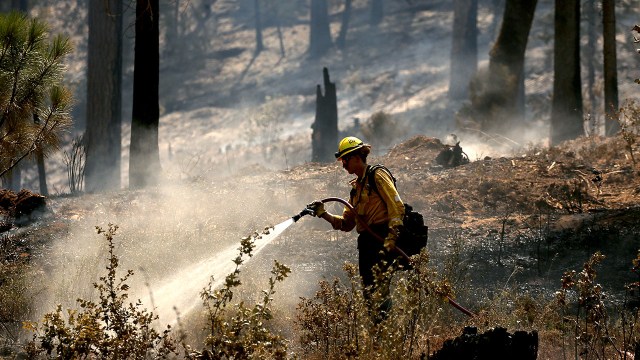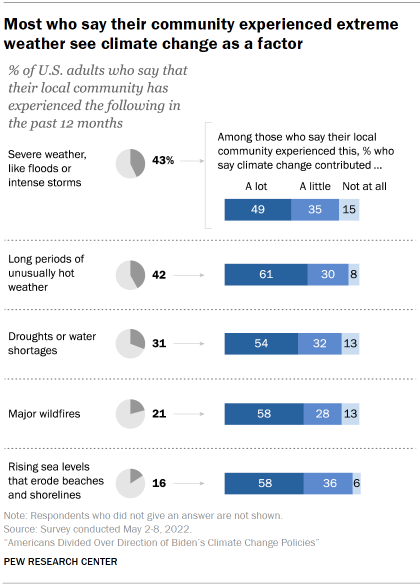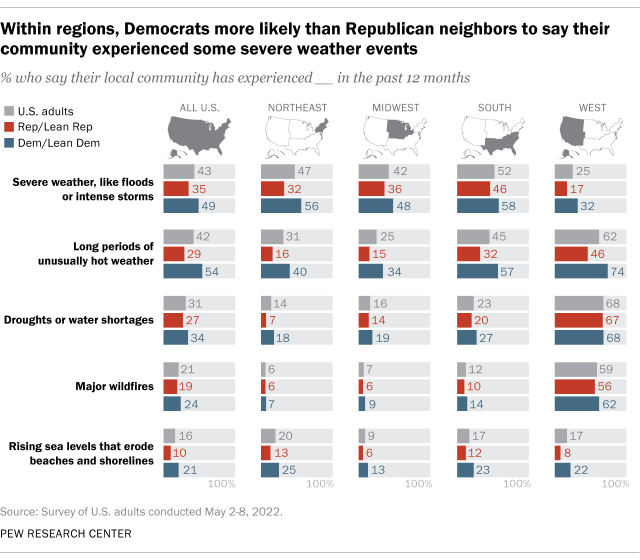
Extreme weather events have affected many parts of the United States, and most Americans who have experienced one in the past year see at least some link to climate change, according to a recent Pew Research Center survey. That includes majorities in both political parties, though Democrats are more likely than Republicans to say climate change contributed a lot to these events.
Pew Research Center conducted this study to understand how Americans experience extreme weather events and perceive the role of climate change in such incidents. For this analysis, we surveyed 10,282 U.S. adults from May 2-8, 2022. Everyone who took part in the survey is a member of the Center’s American Trends Panel (ATP), an online survey panel that is recruited through national, random sampling of residential addresses. This way, nearly all U.S. adults have a chance of selection. The survey is weighted to be representative of the U.S. adult population by gender, race, ethnicity, partisan affiliation, education and other categories. Read more about the ATP’s methodology.
This analysis also relies on data from the National Oceanic and Atmospheric Administration (NOAA), including its Climate Extremes Index (CEI) and the NOAA National Centers for Environmental Information’s U.S. Billion-Dollar Weather and Climate Disasters database. The CEI is a framework for measuring observed changes in climate within the contiguous United States; climate events (including extremes in temperature, precipitation and drought) are characterized as extreme if they are well above or below normal. For more information, read the CEI’s methodology.
Here are the questions used for this analysis, along with responses, and its methodology.

Overall, around four-in-ten Americans say their local community has experienced severe weather like floods and intense storms (43%) or long periods of unusually hot weather (42%) in the past year, according to the May survey of 10,282 U.S. adults. Smaller shares say their community has experienced droughts or water shortages (31%), major wildfires (21%) or rising sea levels that erode beaches and shorelines (16%). The survey was conducted before recent flooding that killed at least three dozen people in Kentucky and before the outbreak of a major wildfire in California.
Collectively, 71% of Americans say their community has experienced at least one of these five forms of extreme weather in the past year. Among those who have, more than eight-in-ten say climate change contributed at least a little to each type of event.
In both parties, majorities of those who have experienced one of the forms of extreme weather asked about in the survey say climate change contributed to the event. But Democrats are more likely than Republicans to say climate change contributed a lot.

For example, among those who say their community has experienced severe weather like floods or intense storms in the past year, 95% of Democrats and Democratic-leaning independents say climate change contributed at least a little, compared with 65% of Republicans and GOP leaners. But while 64% of these Democrats say climate change contributed a lot, just 24% of Republicans say the same.
Similarly, large majorities of both Democrats and Republicans who have experienced long periods of unusually hot weather in their community say climate change contributed at least a little (97% and 79%, respectively). But Democrats are far more likely than Republicans to say climate change contributed a lot (72% vs. 38%).
Partisan differences persist in reported extreme weather events
Despite some common ground, partisans continue to differ in their reported experiences of certain weather events.

Democrats are more likely than Republicans to report that their local community has faced each of the five types of extreme weather asked about in the May survey. Previous Center surveys have found that Democrats assign higher priority to addressing climate change and see a stronger link between human activity and climate change than Republicans.
The partisan gap persists even among Democrats and Republicans who reside within the same region.
In the West, for example, 62% of adults overall report that their community has faced long periods of unusually hot weather in the past year. That includes 74% of Democrats in the region, compared with 46% of Republicans. Similarly, among adults living in the South, Democrats are more likely than Republicans to say their local community experienced severe weather like floods or intense storms in the past year (58% vs. 46%).
Partisan differences are more muted on two other forms of extreme weather included in the survey: wildfires and droughts. That’s especially the case in the West, where some communities have implemented burn bans to address wildfire threats and imposed water restrictions to address severe droughts. Similar shares of Democrats and Republicans in the West (62% and 56%, respectively) report experiencing major wildfires in their community in the past year. And there is virtually no difference in the shares of Western Democrats and Republicans who say their community faced droughts or water shortages in the past year (68% and 67%).
Regional experiences of extreme weather
Large parts of the country have been hit by extreme weather in recent years. In 2021, 43.08% of the contiguous U.S. experienced extremes in temperature, precipitation or drought, according to the National Oceanic and Atmospheric Administration’s Climate Extremes Index (CEI). The 2021 average contiguous U.S. temperature was the fourth-warmest in the CEI’s 127-year period of record, and July 2022 was the third-hottest July on record. Since 2019, there have been 65 weather and climate disasters – including nine so far this year – that have each caused at least $1 billion in damages, according to NOAA.
The effects of extreme weather are felt unevenly across the country. For instance, the Western states of California and Nevada are especially likely to have experienced extremes in maximum temperatures and droughts in 2021, according to the CEI.
Other parts of the U.S. are more likely to face different weather events. In the Southeast, for example, 46.6% of the region experienced severe moisture surplus last year.
Note: Here are the questions used for this analysis, along with responses, and its methodology.



